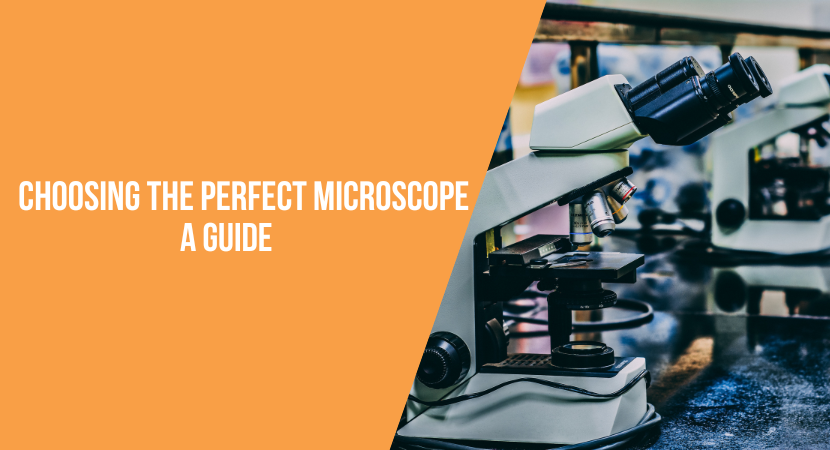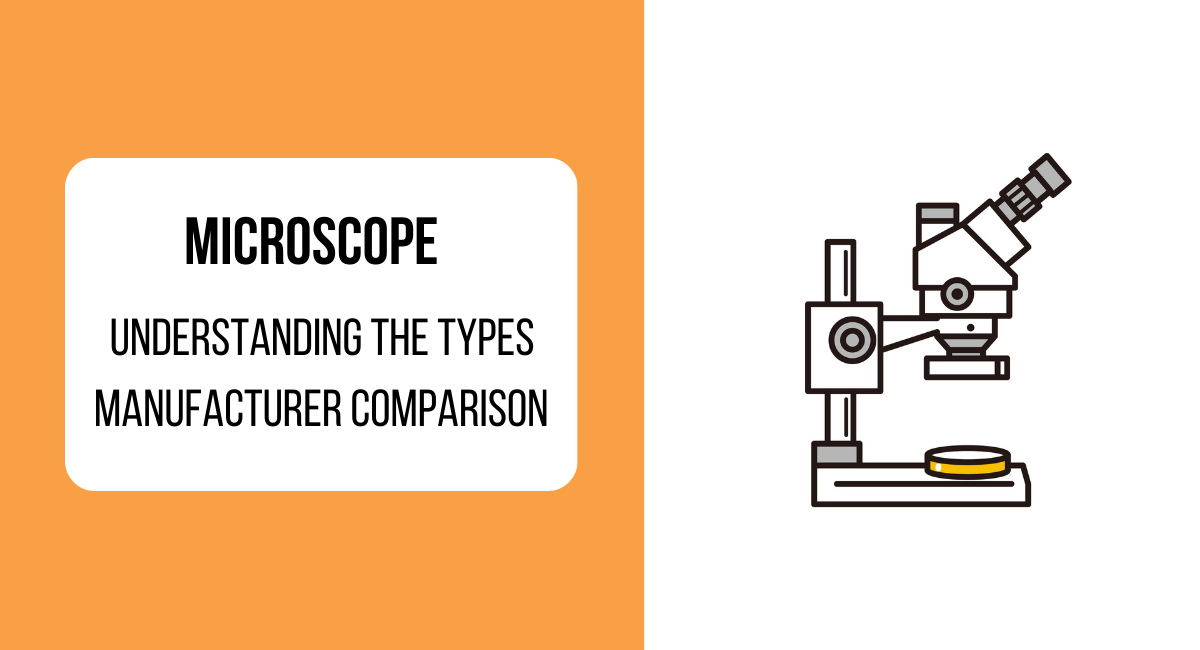Choosing the right microscope is crucial because specifications, prices, and applications can vary significantly. Making the wrong selection may not only lead to unnecessary costs but can also impede research and quality control.
In this article, we’ll delve into the world of microscopes, explaining what they are, providing insights on selecting a recommended digital microscope, outlining the characteristics of various types, and offering valuable points for companies to choose the best microscope for their specific needs.Let’s get started!
目次
What is a Microscope?

A microscope is a device designed for observing minute features invisible to the naked eye.
There are four main types of microscopes:
- Optical Microscopy: Ideal for exploring complex structures and tiny details in cells using visible or near-ultraviolet light
- Electron Microscopy: Utilizes a high-energy electron beam for even smaller object resolution
- Scanning Probe Microscopy: Employs a physical probe to measure surface topography
- Digital Microscope: A digital version of other microscope technologies
Optical Microscopes
Overview: Optical microscopes directly observe the two-dimensional shape of materials and cells.The 4 Major Types of Optical Microscopes are
- Single Application Microscope
- Binocular Microscope
- Phase Contrast Microscope
- Monocular Microscope
Monocular Microscope
A monocular microscope, with a single eyepiece, is perfect for school, hobbies, and simple research.Its uncomplicated structure is beginner-friendly, making it a cost-effective choice for educational institutions and budget-conscious laboratories.It’s small size and portability are ideal for fieldwork and frequent travel, making it suitable for various situations.Binocular Microscope
A binocular microscope, with two eyepieces, offers stereoscopic vision, providing an intuitive understanding of a sample’s 3D structure.Its wide field of view and reduced user fatigue make it suitable for fine work in educational settings, laboratories, and industries.This type is commonly used for tasks such as cell manipulation, dissection, and quality inspection and restoration of works of art.Phase Contrast Microscope
A phase contrast microscope specializes in observing transparent specimens and fine structures within cells.It excels in non-invasive observation, clear contrast expression, and real-time capture of dynamic processes in living cells.It finds applications in various fields, from the study of biological processes to pathogen detection in medicine and microbial testing in food.Electron Microscope
An electron microscope uses an electron beam instead of light to magnify and observe a sample.Two types include the fluorescence microscope and confocal microscope.Fluorescence Microscope
This microscope observes objects through fluorescence and phosphorescence phenomena, making it easy to understand and precise. It utilizes fluorescent markers to target specific molecules or cellular structures, allowing for real-time observation of processes within living cells.It has diverse applications, from studying cell structure and dynamics to drug testing and analyzing drug action mechanisms.Confocal Microscope
A confocal microscope isn’t your average microscope—it’s a powerhouse that produces three-dimensional images with exceptional resolution and contrast.How? By honing in on a specific focal plane and elegantly blurring out the rest.Why Choose Confocal Microscopy?
- Precision and Ease: The real charm of confocal microscopy lies in its precision and user-friendly observation capabilities
- Targeted Observation: Researchers can zero in on specific molecules or cellular structures while blurring the rest, ensuring a crystal-clear identification of what’s under the lens
- Multi-Angle Analysis: It enables the analysis of intricate intracellular processes from multiple perspectives, offering a holistic view
Applications of Confocal Microscopy
- Biomedical Research: Study intricate cell structures and functions in cell and molecular biology
- Drug Development: Observe the effects of new drugs on cells and evaluate their impacts and side effects
- Neuroscience: Delve into detailed observations of neuronal networks and synaptic dynamics
- Developmental Biology: Analyze cell behavior and the differentiation process at each stage of ontogeny
- Materials Science: Explore nanotechnology and microstructural aspects of new materials
Scanning Probe Microscope
Scanning probe microscopes see a lot of use in medical fields, where a tiny needle (probe) traces the surface of a sample to reveal its shape and properties.Let’s quickly go over the types of Scanning Probe Microscopes
- Atomic Force Microscope (AFM)
- Scanning Tunneling Microscope (STM)
Atomic Force Microscope (AFM)
AFM is a game-changer in scientific and engineering landscapes, providing atomic resolution on material surfaces.AFM advantages include
- Atomic-Level Resolution: Achieves extremely high resolution at the atomic level
- Versatility: Ideal for observing biological samples and wet materials without the need for a vacuum environment
- Detailed Analysis: Provides three-dimensional topography, confirming surface roughness and shape with meticulous detail
- Material Insights: Measures mechanical properties and subtle interactions between molecules
Applications of AFM
- Materials Science: Analyze the surface structures of nanomaterials and research new nanocomposite materials
- Semiconductor Industry: Inspect wafer and microchip surfaces
- Biology: Examine surface structures of biomolecules and cells
- Chemistry: Observe catalyst surface activity and the progress of chemical reactions
- Drug Development: Study drug crystal forms and interactions with target molecules
Scanning Tunneling Microscope (STM)
STM takes microscopic exploration to the quantum level, providing atomic-level resolution that surpasses other techniques.STM’s Advantages
- High Resolution: Identifies individual atoms with unparalleled precision
- Conductive Material Focus: Excels in observing conductive and semiconductor materials
Applications of STM
- Physics: Contributes to the development of new materials and the study of surface states
- Chemistry: Elucidates the self-assembly process of catalyst surfaces and molecules
- Materials Science: Investigates new materials in nanotechnology.
- Semiconductor Industry: Analyzes surfaces and detects defects in wafers and chips
- Surface Science: Explores chemical reactions on surfaces
Digital Microscope
In the age of innovation, digital microscopes take center stage with their integration of digital cameras instead of eyepieces.In general, there are four types of Digital Microscopes
- USB Microscope
- Microscope with Camera
- Microscope with Monitor (Video)
- Small Microscope (Handheld Type)
USB Microscope
Revolutionizing the accessibility of science, USB microscopes are compact, easy to use, and changing the game in various applications.Applications of USB Microscopes
- Industrial Design: Perfect for checking intricate product details and making continuous improvements
- Cultural Heritage: Records the condition of ancient documents and works of art, preserving them digitally
- Entertainment: Creates visual content by scanning living things and objects in high resolution
- Medical Care: Observes skin conditions and cell changes, supporting diagnosis
- Education: Conducts experiments in science and biology classes
Microscope with Camera
Microscopes with synchronized cameras and user-friendly software provide real-time image sharing and analysis.Applications of Microscopes with Cameras
- Life Science: Observes cells and tissues, analyzes biological processes
- Medical Research: Detailed observations in clinical trials and pathological diagnosis
- Manufacturing: Quality assurance and inspection of electronic components and precision machinery
- Education: Experiments and demonstrations in schools and universities
- Materials Science: Fine analysis in research and development of new materials and compounds
Microscope with Monitor (Video): Real-Time Exploration
Monitored microscopes offer a real-time visual experience, fostering collaboration and learning in various fields.Applications of Monitored Microscopes
- Education: Experiments and demonstrations for pupils and students
- Manufacturing Industry: Investigating minute defects in products during quality control
- Biology: Tracking and observing the movement and cell dynamics of living organisms in real time
- Medical: Demonstrating detailed surgeries and observing minute parts during clinical examinations
- Forensic Science: Detailed analysis of evidence collected at a crime scene
Small Microscope (Handheld Type)
For the modern scientist on the go, handheld miniature microscopes offer instant observation and analysis in the field.Applications of Small Microscopes
- Quality Inspection: Rapid identification of minute defects in products
- Research and Development: Characterization of new materials in the field
- Medical Field: Quick diagnostic support for clinical samples
- Field Verification: Detailed analysis at construction and forensic sites
So far, we’ve explored the types of microscopes.
In the next section, let’s delve deeper into the incredible uses of these machines.If you’re curious about specific uses or situations where microscopes shine, keep reading!
Microscope Uses

Microscopes are powerful tools that bring the invisible to life. Their ability to show us the inner workings of matter have helped them find their place in various sectors, contributing significantly to advancements and breakthroughs.
Let’s explore how these remarkable devices play pivotal roles in diverse industries.
Medical Industry: Precision for Patient Care
In the realm of medical technology, microscopes are indispensable, ensuring accuracy from pathological diagnoses to combating infectious diseases.Here’s where they shine
- Detailed Disease Diagnosis: Observing the structures of cells and tissues aids in diagnosing diseases accurately
- Enhanced Diagnostic Accuracy: Precise examination of cell morphology improves diagnostic precision
- Pathogen Identification: Identifying pathogens is crucial in understanding and treating infectious diseases
- Medical Research: Microscopes unveil cell movements and tissue interactions, driving medical advancements
Impact on Medical Care
- Tailored Treatments: Accurate pathological diagnosis guides treatment selection for improved patient outcomes
- Infectious Disease Management: Identifying pathogens aids in drug prescription and preventive measures
- Treatment Evolution: Microscopy contributes to drug development and innovative treatments
Biological Studies
At the heart of biological exploration, microscopes are indispensable tools for understanding life’s intricate mechanisms.In biology, microscopes are used for
- Microscopic Structures: Visualizing internal cell structures and the double helix of DNA
- Real-Time Biological Processes: Observing processes from protein synthesis to cell division
- Microbiology: Identifying and studying microorganisms like bacteria, fungi, and protists
- Protein Localization: Observing the movement of proteins within cells
- Intracellular Structures: Researching cell organelles, their structure, and functions
Contributions to Advancements
- Drug Development: Microscopes play a vital role in evaluating new drug candidates
- Genetic Engineering: Discoveries through microscopy drive genetic engineering advances
Metal Processing Industry : Detailed Precision
In metal processing, microscopes are deployed for detailed observations, quality assurance, and process improvement.Key applications include:
- Weld Surface Quality: Observation and quality assurance of weld surface quality and metal fatigue microstructure
- Failure Analysis: Identifying product defects in failure analysis
- Long-Term Effects: Understanding the effects of long-term use and evaluating product durability
- Manufacturing Improvement: Enhancing manufacturing processes through meticulous observation
- Structural Defect Detection: Early detection of structural defects and cracks for safety
Impact on Industry
- Resource Efficiency: Quick identification of failure reduces resource consumption and maintenance costs
- Production Line Efficiency: Early defect detection minimizes production line stoppage, improving efficiency
Chemical Industry
Microscopes are invaluable in the chemical industry, facilitating catalyst performance measurement and detailed analysis.Their applications include:
- Catalyst Surface Structure: Measuring catalyst surface structure and particle size for optimal performance
- Quality Assurance: Analyzing particle size and distribution for quality assurance and process optimization
- Microstructure Insights: Elucidating microstructure for the development of new catalysts and materials
- Reaction Efficiency: Improving reaction efficiency through precise surface analysis
Driving Innovations
- Cost Reduction: Efficient catalyst usage reduces raw material and manufacturing costs
- Product Quality: Uniform product quality achieved through strict control of particle size
- Market Competitiveness: Stricter quality control promotes product innovation and market competitiveness
Semiconductor Industry
In the semiconductor industry, microscopes are essential for detecting micro defects, ensuring product functionality, and advancing technology.Key applications include
- Micro Defect Detection: Early detection of micro defects in the manufacturing process
- Circuit Pattern Formation: Confirming circuit pattern formation during wafer inspection
- Manufacturing Process Improvement: Identifying defects for continuous process improvement
- Prototype Inspection: Ensuring functionality during new manufacturing technology development
Boosting Efficiency
- Reduced Production Downtime: Early defect detection minimizes production line stoppage time
- Cost Reduction: Identifying defects early reduces overall manufacturing costs
Environmental Science
In environmental science, microscopes play a crucial role in detailed particle analysis and pollution monitoring.Applications include
- High-Resolution Imaging: Visualizing microparticles and contaminants with high-resolution imaging
- Particle Identification: Identifying contaminants by chemical properties and particle shape
- Contamination Evaluation: Quantitatively evaluating the degree of contamination through particle analysis
- Air and Water Quality Monitoring: Monitoring air pollution and identifying harmful particles in atmospheric and water analysis
Protecting Our Environment
- Real-Time Monitoring: Regular analysis allows real-time monitoring of environmental pollution
- Health Risk Assessment: Pollutant identification and quantitative analysis contribute to human health risk assessment
Quality Management : Maintaining Product Quality
Widely used in manufacturing-related industries, microscopes are critical for quality control, ensuring compliance with standards, and enhancing innovation.Key purposes include
- Regulatory Compliance: Ensuring compliance with domestic and international standards
- Safety Assurance: Thorough inspection for the safety of food, medicine, and mechanical parts
- Product Quality: Ensuring consistent quality through precise inspections
- Defect Reduction: Reducing defective products, preventing economic losses, and enhancing consumer trust
Strategic Impact
- Innovation Promotion: Stricter quality control promotes manufacturing process improvement and product innovation
- Market Trust: Consistent quality maintenance builds consumer trust and brand reputation
Jewelry Industry
In the meticulous world of jewelry, microscopes are essential for evaluating gemstone quality, craftsmanship, and intricate details.Applications in the jewelry industry include
- Scratch and Defect Analysis: Identifying minute scratches and defects in expensive jewelry and precious metals
- Quality Evaluation: Evaluating product quality and verifying the beauty of intricately processed items
- Material Authenticity: Distinguishing between real and fake through detailed internal structure inspection
- Gemstone Inspection: Examining inclusions, determining types, and assessing gem cut quality
Preserving Elegance
- Craftsmanship Verification: Confirming complex and precise processing technology
- Material Insight: Microscopes aid in understanding the value of each gemstone or precious metal product
A Guide to Choosing the Right Microscope

Selecting the right microscope involves careful consideration based on specific needs.Your needs may vary depending on whether you wish to use it for commercial purposes, medical reasons or several other factors. Here’s our guide for you to follow that will help make the process simpler:
Purpose
- Biological Samples: Monocular or binocular microscopes
- Inorganic Materials: AFM or STM for atomic-level observation
- Organic Materials: Binocular microscopes
- Particles in Liquids: Phase contrast or fluorescence microscopy
- Nanomaterials: Confocal or AFM for 3D images
Magnification Rate
- Low Magnification (5x – 50x): Surface inspection and assembly work
- Medium Magnification (50x – 200x): Fine print inspection and quality control
- High Magnification (200x – 1000x): Cell observation, microbial research, and pollutant analysis
Required Magnification
- 10x – 40x: Quality checks in manufacturing, assembly inspection of automobile parts
- 100x: Examining histological specimens, observing plant tissues, reverse engineering
- 200x – 400x: Analysis of pollutants in environmental science, particle size measurements in the chemical industry
- 500x – 1000x: Observing blood cells, microbiology research, clinical testing
- 1000x and above: Specialized scientific research, nanoscale material characterization
Live Imaging
- USB Microscope: General observation, education, and hobby use
- Camera-Attached Microscope: Samples requiring image recording or digital analysis
- Microscope with Monitor (Video): Teaching, presentations, detailed observation on a large screen
- Compact Microscope (Handheld Type): Quick observation in the field, portable use
Working Distance
- Microscopes for Various Purposes: Choose based on sample type and intended application
Sample Size
- Various Microscope Types: Suitable for observing different sample sizes
Cost
- Budget Consideration: Choose a microscope that meets requirements without overspending
Durability and Maintenance
- High-Quality Build: Choose microscopes from reputable manufacturers for durability
Selecting the right microscope ensures success, from scientific discoveries to industrial applications.These powerful tools continue to shape our understanding of the world, one microscopic detail at a time.
For more detailed information and tailored advice on choosing the best microscope for your specific needs, keep reading our next section!
Microscope Selection Guide: Navigating Key Considerations
Selecting the right microscope is a crucial step when it comes to determining the success of your project, be it in scientific research, industrial applications, or educational settings.In our microscope guide, we’ll take a deep dive into the essential factors to consider when choosing a microscope tailored to your specific needs.
1.Live Imaging Capability: Witnessing Dynamic Processes
Live imaging is indispensable and incredibly useful for observing dynamic biological or chemical processes over time.Consider the following
- Frame Rate: Higher frame rates are crucial for capturing fast-moving processes
- Resolution: Optimal resolution ensures clarity in observing intricate details
Industries Benefiting from Live Imaging
- Biology and Life Sciences: Essential for studying living samples, cell movements, and molecular interactions
- Medicine and Medical Research: Required for surgeries, disease diagnosis, and treatment monitoring
- Neuroscience: Vital for real-time observation of neuron activity and neural circuits
- Materials Science: Crucial for stress testing and real-time observation of material deformation
2. Working Distance: Account for Practical Maneuverability
The working distance, the space between the sample and the lens, is critical for practical usability.Considerations include
- Specified in Spec Sheets: Check manufacturer-provided spec sheets for working distance information
- Focal Length Relation: Longer focal lengths generally correspond to longer working distances
Applications Requiring Adequate Working Distance
- Inspecting Large Samples: Such as car parts or sizable electronic equipment
- Surgical Microscopy: Ensures space for manipulating surgical instruments
- Biological Sample Manipulation: Crucial for working with cell cultures or tissue sampling
- Industrial Assembly Lines: Enhances ease of hand movement for production line workers
- Jewelry and Micro-Work Inspection: Essential for precise examination of small, intricate parts
3. Sample Size: Matching Microscope to Object Dimensions
The physical size of the object you’re observing, including the smallest features, is key for effective microscopy.Consider:
- Compatibility: Choose a microscope that accommodates the size of your sample
- Magnification Needs: Ensure the selected microscope provides the necessary magnification for detailed observation
Microscope Types Based on Sample Size:
- Nanomaterials and Semiconductors: Atomic Force Microscope (AFM) or Scanning Tunneling Microscope (STM)
- Small Samples (Cells and Bacteria): Fluorescence Microscope, Phase Contrast Microscope, Confocal Microscope
- Medium-Sized Samples: Binocular Microscope, Phase Contrast Microscope, Fluorescence Microscope
- Large Samples: Binocular Microscope, Microscope with Monitor (Video), USB Microscope
- Very Large Samples: Microscope with Camera, Microscope with Monitor (Video), Small Microscope (Handheld Type)
4. Durability and Maintenance: Long-Term Reliability
The durability and maintenance needs of a microscope are crucial for seamless and long-term use.Consider
- Quality of Materials: Opt for high-quality builds for durability
- Maintenance Frequency: Choose a maintenance frequency suitable for your application
Maintenance Considerations Across Industries
- Medical Industry: Typically requires maintenance every three months
- Biology: General maintenance intervals around three months
- Metal Processing Industry: Common maintenance every six months
- Chemical Industry: Maintenance intervals ranging from three to six months
- Semiconductor Industry: Common maintenance every three months
- Environmental Science: Maintenance generally every six months
- Quality Control: Typically performed annually or every six months
- Jewelry Industry: Maintenance intervals of one year to six months
Comparing Microscope Manufacturers: A Closer Look

Diving into microscope manufacturers reveals insights into their strengths and product offerings.These manufacturers each have their own specialized technologies and have microscopes for a wide variety of uses.
Here are six recommended manufacturers
Olympus
- History: Since 1919, leading in precision instruments and optical products.
- Product Range: Offers a wide spectrum from monocular to digital microscopes
- Quality Assurance: Adheres to strict quality control under ISO 9001 standards
- Warranty: Typically one year, varies by product
Leica Microsystems
- History: Established in 1849, known for continuous innovation
- Product Portfolio: From monocular to digital microscopes, supporting basic to advanced research
- Quality Control: Holds multiple international certifications, including ISO 9001
- Warranty: Typically one year, varies based on the product
Nikon
- History: Founded in 1917, a pioneer in optical and digital technology
- Product Diversity: Offers a broad product portfolio for various applications
- Quality Assurance: Complies with international standards, emphasizing consistent quality
- Warranty: Typically one year, specifics vary with each product
Keyence
- Innovation: Established in 1974, excelling in industrial measurement equipment
- Advanced Technology: Specializes in digital microscopes for quality assurance
- Quality Control: Implements strict systems in line with ISO 9001
- Warranty: Typically one year, with possible extensions
Hozan
- Legacy: Founded in 1946, recognized in precision tools and industrial microscopes
- Product Range: Offers monocular, binocular, and digital microscopes
- Quality Standards: Adheres to international quality control standards
- Warranty: Typically one year, varies by product
Thanko
- Innovation: Known for unique electronic products, including digital microscopes
- Product Brands: Dino-Lite and Dino-Lite Pro for diverse needs
- Quality Certification: ISO 9001 certified, ensuring high standards
- Warranty: Typically one year, covering manufacturing defects
Purchasing your own Microscope
Choosing the right microscope involves a careful consideration of your specific requirements.Whether you’re delving into the intricacies of biological processes, inspecting industrial materials, or exploring the microscopic realm in education or business, we hope our carefully crafted guide equips you with the knowledge needed to make an informed decision.
If you have any questions or concerns regarding any of the topics mentioned here or require help choosing a company, please contact us. Our team of specialists would be happy to help you!
Contact Us Today

